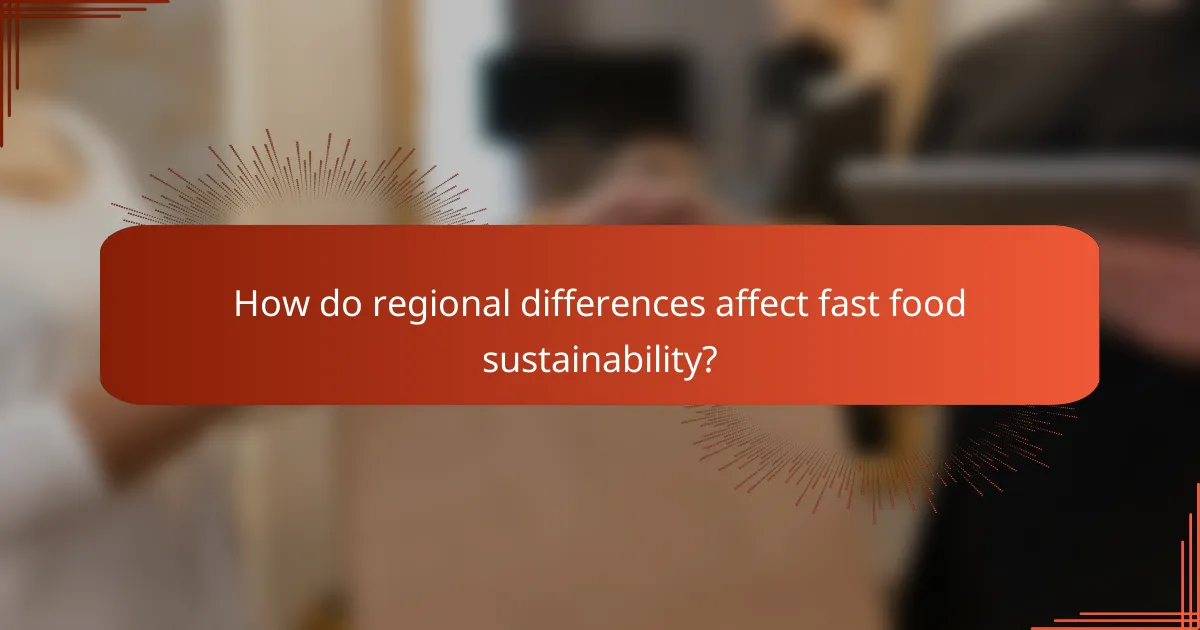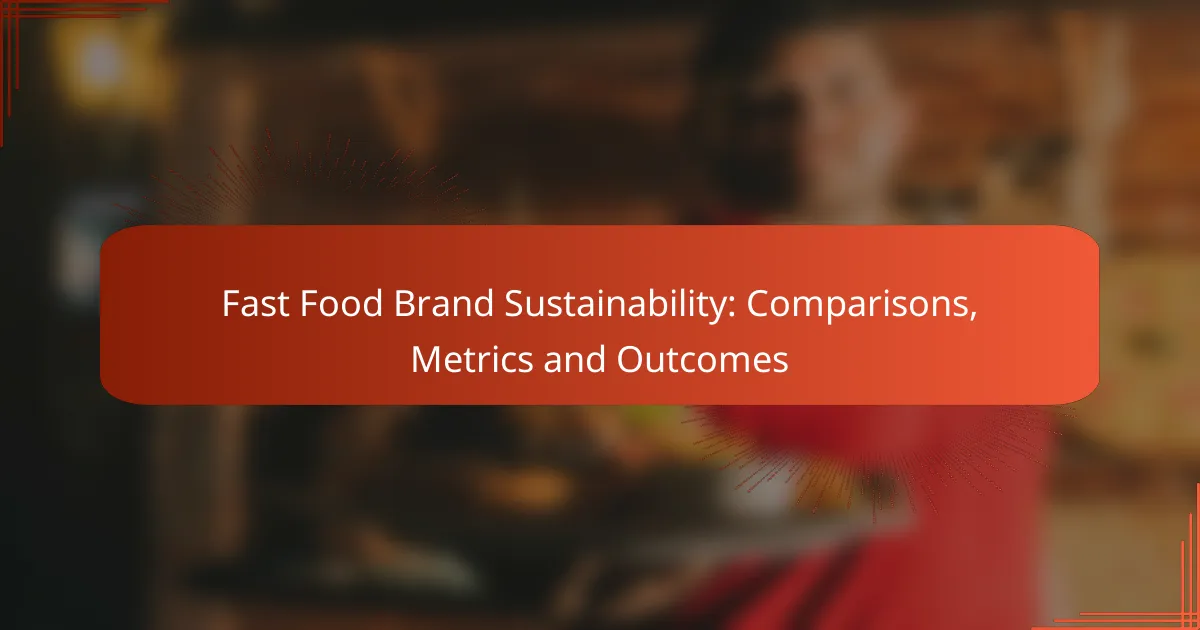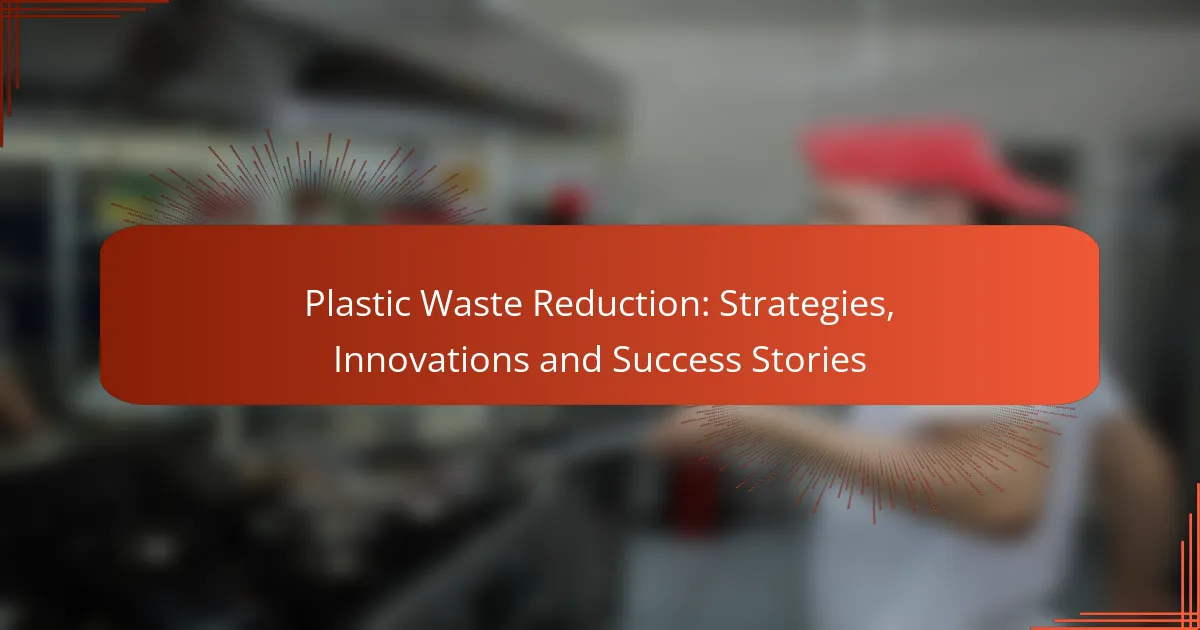As fast food brands increasingly prioritize sustainability, their efforts can vary widely, particularly in areas like sourcing, waste management, and animal welfare. By examining the metrics used to assess these initiatives, such as carbon footprints and waste diversion rates, consumers can make more informed dining choices that align with their values. Ultimately, these sustainability efforts not only enhance brand perception but also foster loyalty and drive sales in a competitive market.

How do fast food brands compare in sustainability efforts?
Fast food brands vary significantly in their sustainability efforts, focusing on areas such as sourcing, waste management, and animal welfare. Understanding these differences can help consumers make informed choices about their dining options.
McDonald’s sustainability initiatives
McDonald’s has implemented several sustainability initiatives aimed at reducing its environmental footprint. The company has committed to sourcing 100% of its packaging from renewable, recycled, or certified sources by 2025.
Additionally, McDonald’s is working to reduce greenhouse gas emissions across its supply chain and has set a goal to achieve net-zero emissions by 2050. This includes investing in renewable energy and sustainable agriculture practices.
Starbucks environmental practices
Starbucks focuses on environmental practices that include reducing waste and conserving water. The company aims to eliminate plastic straws and has introduced reusable cups to minimize single-use plastics.
Starbucks also emphasizes ethical sourcing of coffee through its Coffee and Farmer Equity (C.A.F.E.) Practices, which ensure that coffee is sourced in a socially responsible manner. This program supports farmers and promotes sustainable farming methods.
Subway’s sourcing transparency
Subway prioritizes sourcing transparency by providing detailed information about its ingredients and supply chain. The brand has made commitments to source meats without antibiotics and to use cage-free eggs in its operations.
Subway also engages in initiatives to improve the sustainability of its packaging, aiming to reduce plastic waste. This transparency helps customers make informed choices about their food sources.
Wendy’s waste reduction strategies
Wendy’s has implemented waste reduction strategies that include recycling and composting efforts in its restaurants. The company aims to divert a significant portion of its waste from landfills through these initiatives.
Wendy’s is also focused on reducing food waste by optimizing inventory management and donating surplus food to local food banks. This approach not only minimizes waste but also supports community needs.
Chick-fil-A’s animal welfare policies
Chick-fil-A is committed to animal welfare, emphasizing humane treatment in its supply chain. The company has established guidelines for sourcing chicken, ensuring that suppliers adhere to high animal welfare standards.
In addition to animal welfare, Chick-fil-A is working towards more sustainable sourcing practices, including the use of cage-free eggs and antibiotic-free chicken. These policies reflect a growing consumer demand for ethically sourced food options.

What metrics are used to measure sustainability in fast food?
Fast food sustainability is typically measured using various metrics that evaluate environmental impact, resource usage, and waste management. Key metrics include carbon footprint analysis, water usage metrics, waste diversion rates, and supply chain sustainability scores.
Carbon footprint analysis
Carbon footprint analysis assesses the total greenhouse gas emissions produced by a fast food brand, often measured in carbon dioxide equivalents (CO2e). This metric helps brands understand their contribution to climate change and identify areas for improvement.
Common practices include calculating emissions from energy use, transportation, and food production. Brands may aim to reduce their carbon footprint by implementing energy-efficient technologies or sourcing ingredients locally to minimize transportation emissions.
Water usage metrics
Water usage metrics evaluate the amount of water consumed throughout the fast food supply chain, from ingredient production to restaurant operations. This metric is crucial as water scarcity becomes a growing concern in many regions.
Fast food brands can track water usage in various areas, including food preparation, cleaning, and irrigation for crops. Strategies to reduce water consumption include adopting water-efficient appliances and sourcing ingredients from suppliers with sustainable water practices.
Waste diversion rates
Waste diversion rates measure the percentage of waste that is recycled, composted, or otherwise diverted from landfills. This metric indicates how effectively a fast food brand manages its waste and contributes to circular economy practices.
Brands often set targets for waste diversion, aiming for rates of 50% or higher. Effective strategies include implementing recycling programs, reducing packaging waste, and educating staff and customers on proper waste disposal methods.
Supply chain sustainability scores
Supply chain sustainability scores assess the environmental and social practices of suppliers within a fast food brand’s supply chain. This metric helps brands ensure that their ingredients are sourced responsibly and ethically.
Brands may use third-party assessments or develop their own scoring systems based on criteria such as labor practices, environmental impact, and resource management. Collaborating with suppliers to improve sustainability practices can enhance overall scores and brand reputation.

What are the outcomes of sustainability initiatives in fast food?
Sustainability initiatives in fast food lead to various positive outcomes, including enhanced consumer perception, increased sales, and improved brand loyalty. These initiatives often focus on environmentally friendly practices, ethical sourcing, and waste reduction, which resonate well with today’s consumers.
Consumer perception improvements
Fast food brands that adopt sustainability initiatives often see a significant boost in consumer perception. Customers are increasingly favoring companies that demonstrate a commitment to environmental and social responsibility. This shift can lead to a more favorable brand image and greater trust among consumers.
For instance, brands that highlight their use of organic ingredients or eco-friendly packaging can attract a demographic that prioritizes health and environmental impact. Engaging in transparent communication about sustainability efforts can further enhance this perception.
Sales growth linked to sustainability
There is a notable correlation between sustainability initiatives and sales growth in the fast food sector. Brands that implement eco-friendly practices often experience an uptick in sales, as consumers are willing to pay a premium for products that align with their values. This trend is particularly evident among younger consumers who prioritize sustainability.
For example, fast food chains that introduce plant-based menu items or commit to reducing plastic waste may see sales increases in the range of 10-20%. Offering promotions or loyalty rewards tied to sustainable choices can also drive additional revenue.
Brand loyalty enhancements
Sustainability initiatives can significantly enhance brand loyalty among consumers. When customers perceive a brand as socially responsible, they are more likely to return and recommend it to others. This loyalty can translate into repeat business and long-term customer relationships.
To foster this loyalty, fast food brands should actively engage with their customers about their sustainability efforts. Implementing loyalty programs that reward eco-friendly choices or sharing success stories about sustainability can strengthen the emotional connection with consumers.

What frameworks guide fast food sustainability practices?
Fast food sustainability practices are guided by various frameworks that help brands measure and improve their environmental and social impact. Two prominent frameworks are the Global Reporting Initiative (GRI) and the Sustainable Development Goals (SDGs), which provide guidelines and metrics for assessing sustainability efforts.
Global Reporting Initiative (GRI)
The Global Reporting Initiative (GRI) offers a comprehensive framework for organizations to report on their sustainability performance. It emphasizes transparency and accountability, allowing fast food brands to disclose their environmental, social, and governance (ESG) impacts.
Brands using GRI standards typically focus on key performance indicators such as energy consumption, waste management, and supply chain sustainability. For example, a fast food chain might report on its reduction in greenhouse gas emissions or improvements in sourcing sustainable ingredients.
Sustainable Development Goals (SDGs)
The Sustainable Development Goals (SDGs) are a set of 17 global objectives established by the United Nations to address pressing social and environmental challenges. Fast food brands align their sustainability initiatives with specific SDGs, such as responsible consumption and production or climate action.
By integrating SDGs into their business strategies, fast food companies can prioritize initiatives like reducing food waste or improving labor practices. For instance, a brand may commit to sourcing 100% of its packaging from renewable or recycled materials by a certain year, contributing to multiple SDGs simultaneously.

How do regional differences affect fast food sustainability?
Regional differences significantly impact fast food sustainability by influencing regulations, consumer preferences, and supply chain practices. These factors shape how brands implement eco-friendly initiatives and measure their effectiveness across various markets.
North America vs Europe sustainability standards
In North America, fast food sustainability standards often focus on waste management and energy efficiency, with many brands adopting practices like recycling and energy-efficient appliances. However, European standards tend to be more stringent, emphasizing carbon footprint reduction and sustainable sourcing of ingredients.
For example, the European Union has set ambitious targets for reducing greenhouse gas emissions, which compel fast food chains to adopt more comprehensive sustainability measures. In contrast, North American brands may prioritize consumer convenience over environmental impact, leading to a slower adoption of sustainable practices.
Asia-Pacific sustainability initiatives
In the Asia-Pacific region, fast food sustainability initiatives vary widely, influenced by local regulations and cultural attitudes toward environmental issues. Countries like Japan and Australia are leading the way with innovative approaches, such as reducing plastic usage and promoting plant-based menu options.
Fast food brands in this region are increasingly focusing on local sourcing to minimize transportation emissions and support local economies. However, challenges remain, such as balancing rapid growth with sustainable practices, particularly in emerging markets where demand for fast food is surging.

What emerging trends are shaping fast food sustainability?
Emerging trends in fast food sustainability focus on reducing environmental impact through innovative practices. Key areas include the introduction of plant-based menu items and advancements in waste management technologies.
Plant-based menu innovations
Plant-based menu innovations are becoming increasingly popular as fast food brands seek to cater to health-conscious and environmentally aware consumers. These offerings often include meat alternatives made from ingredients like soy, peas, and mushrooms, which can significantly lower greenhouse gas emissions compared to traditional meat production.
Brands like Burger King and McDonald’s have introduced plant-based burgers that appeal to a broader audience, helping to reduce reliance on animal agriculture. Fast food chains are also experimenting with plant-based sides and desserts, enhancing their menus while promoting sustainability.
Technological advancements in waste management
Technological advancements in waste management are crucial for improving sustainability in the fast food industry. Many brands are adopting systems that track waste generation and implement strategies to minimize it, such as composting organic waste and recycling packaging materials.
For instance, some chains are using smart bins equipped with sensors to monitor waste levels, allowing for more efficient collection and reducing overflow. Additionally, partnerships with local composting facilities can help divert food waste from landfills, aligning with sustainability goals and local regulations.



